France developed this tasteful Crèvecoeur chicken breed intending to generate a delicious table bird. Egg production is a minor priority for this breed. The primary use for this beautiful black chicken is for meat production and exhibition.
How did this gorgeous and black-crested chicken get its urbane name too? This fowl with a V-shaped comb got its name from the Crèvecœur village in Auge Normandy, France.
“Crève Cœur” means “broken heart” in English as the location’s land in the region is less fertile so breaking the hearts of the farmers and peasants. Crèvecoeur birds are one of France’s oldest standard-bred chickens.
This article will cover
- History of Crèvecoeur Chicken Breed
- Crèvecoeur Fowl Breed Standard And Appearance
- Crèvecœur Chickens’ Personality and Temperament
- Crèvecœur Chicken Egg Laying Details
- Crèvecœur Chickens Health Issues and Care
- 5 Tips For Raising Crèvecœur Chickens
History of Crèvecoeur Chicken Breed
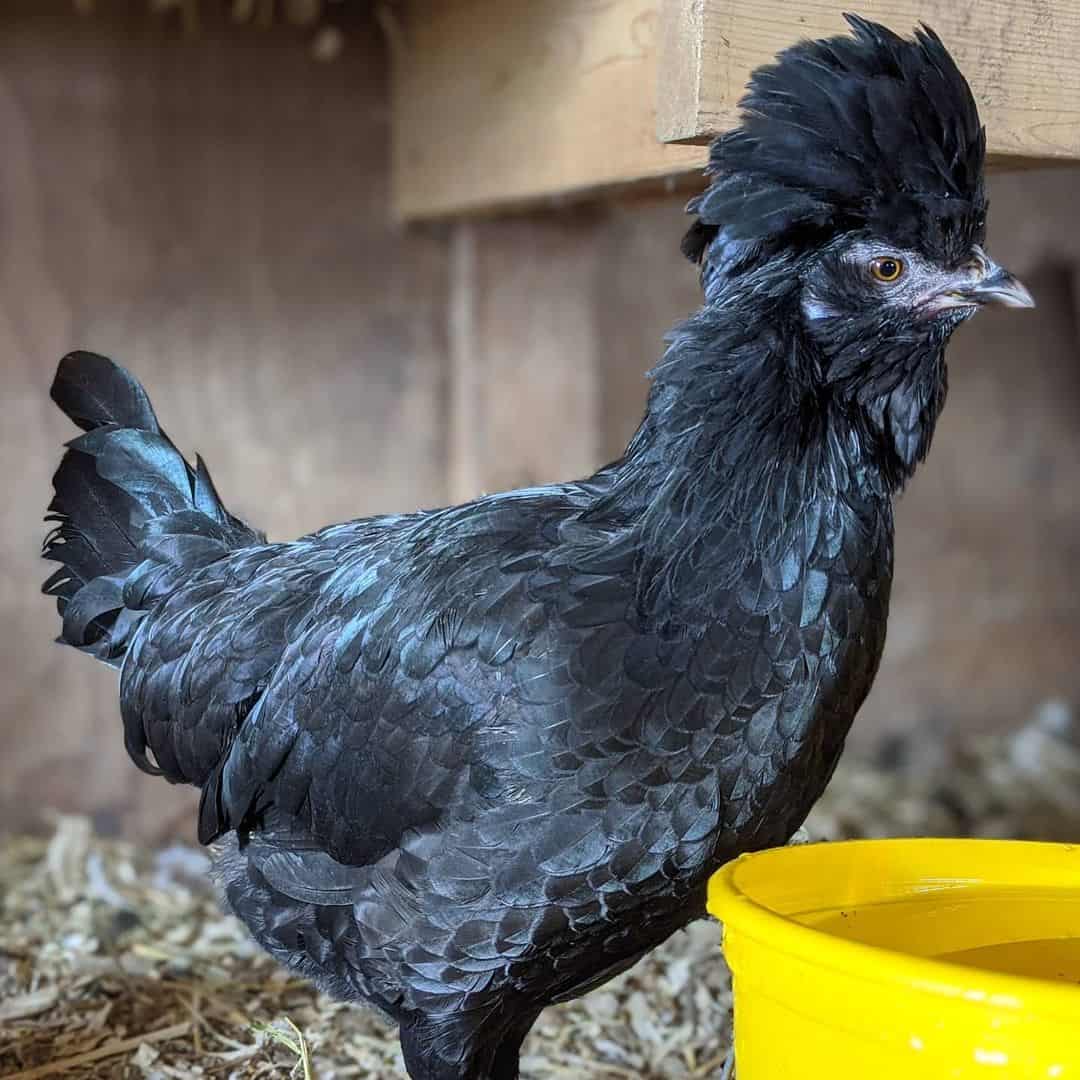
There’s not much known of the origin of the Crèvecoeur chicken breed other than its development in Normandy, where it existed for a very long time.
There was much value to the Crèvecoeur chicken from the locals, especially in the 12th century when the tenants pay rent on their farm with two Crèvecoeur capons to the landowner every year. And in the 18th century, the upper-middle-class preferred Crèvecoeur as their table bird in Paris. There were more than 150,000 Crèvecoeur fowls produced every year in the market.
This French black chicken reached the US in 1852 when French fowl strains were prevalent. A.M. Halstead and Mr. Saunders of New York and Benjamin Haines of Elizabeth, New Jersey imported the Crèvecoeur chickens in 1967 from the Jardin d’Acclimation in Paris according to the American Agriculturist published in March 1867. There were more imports during the 1820s from the exact location because they were still famous in France.
In 1940, German soldiers reached Normandy, and things severely changed for the Crèvecœur breed of chicken during World War II.
The German army demanded to eat like the French middle-class did, so they collected as many of the Crèvecœur fowls for their meals. Only a few remained of this chicken breed hidden by devoted farmers within two years as almost all the fowls were eaten.
The Crèvecœur breed of chickens is still on the list of critically endangered species. But Australia, France, and the US hatcheries bring this historic French breed back to our table. Hopefully, the numbers will improve as more backyard chicken breeders carry this breed.
Crèvecoeur Fowl Breed Standard And Appearance
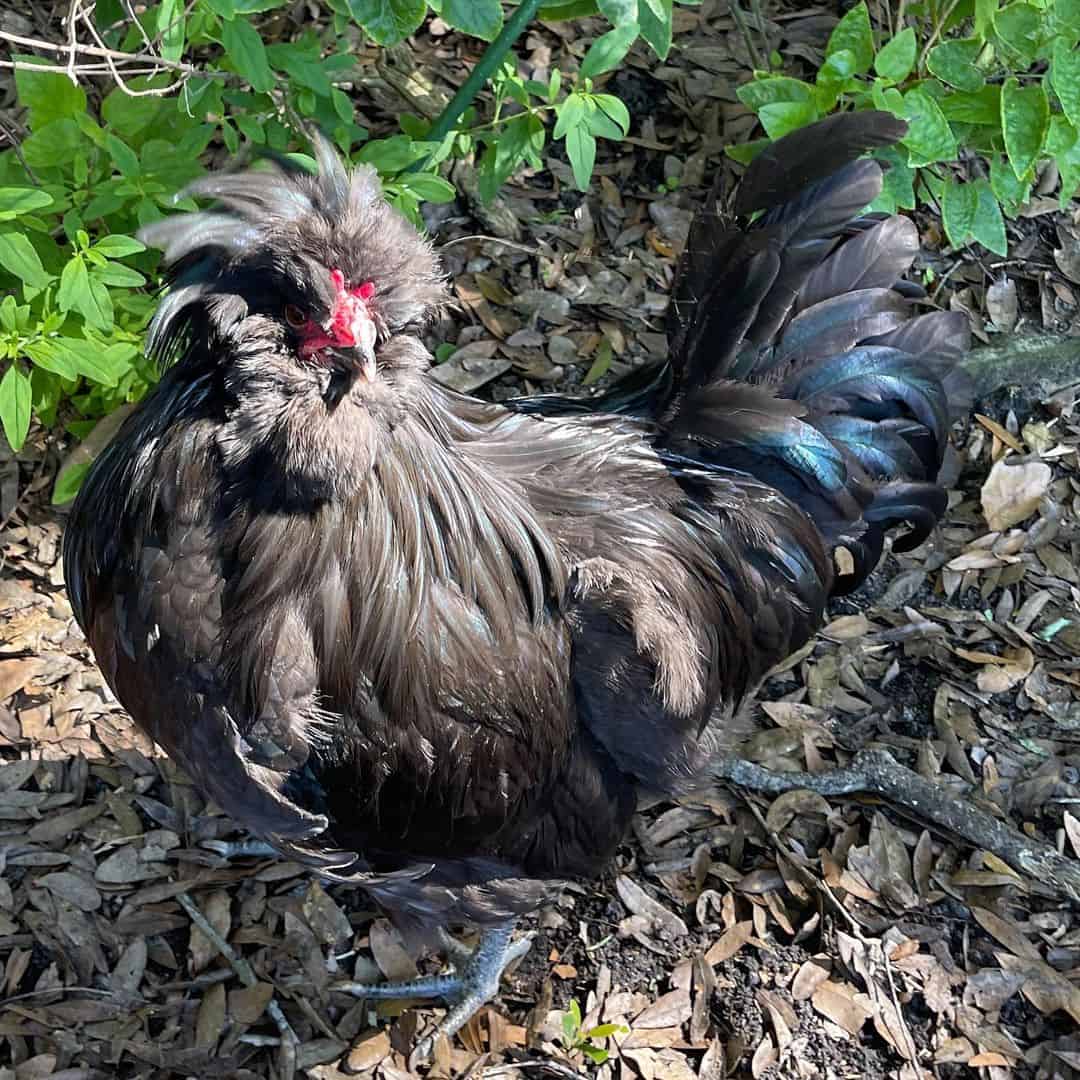
Crèvecœur chickens in the US are primarily solid black in color. Still, in 2017, they began to import the blue, white, and splash varieties from France.
The American Poultry Association (APA) only recognizes one type of the Crèvecœur chicken even when a few nonstandard colors were developed by fowl breeders. There’s also a bantam version of the Crèvecœur fowl breed. APA recognized and admitted the Crèvecœur chicken in 1874.
These chickens from France possess a green beetle sheen visible on the roosters’ hackles, crests, and tail feathers. In general, these chickens have condensed but well-proportioned bodies and short legs. These birds as well have moderate-sized but striking crests and beards that are different from other breeds.
First of all, their crests come out of lumps of bone on their skull. Also, their beards are a split of two muffs and a beard which means these fowls are tri-lobed. Some of Crèvecœur chicks were without beards when they were born.
The Crèvecœur’s crest appears to be similar to the Houdan chicken breed. The only difference from these chickens is that Crèvecœur is four-toed.
These chickens’ crests and beards instead hide their small earlobes. The APA sets a standard Crèvecœur chicken earlobe color red where in France, their standard is whitish. Surprisingly, the American Crèvecœur are the few chicken strains that don’t have white earlobes but lay white eggs.
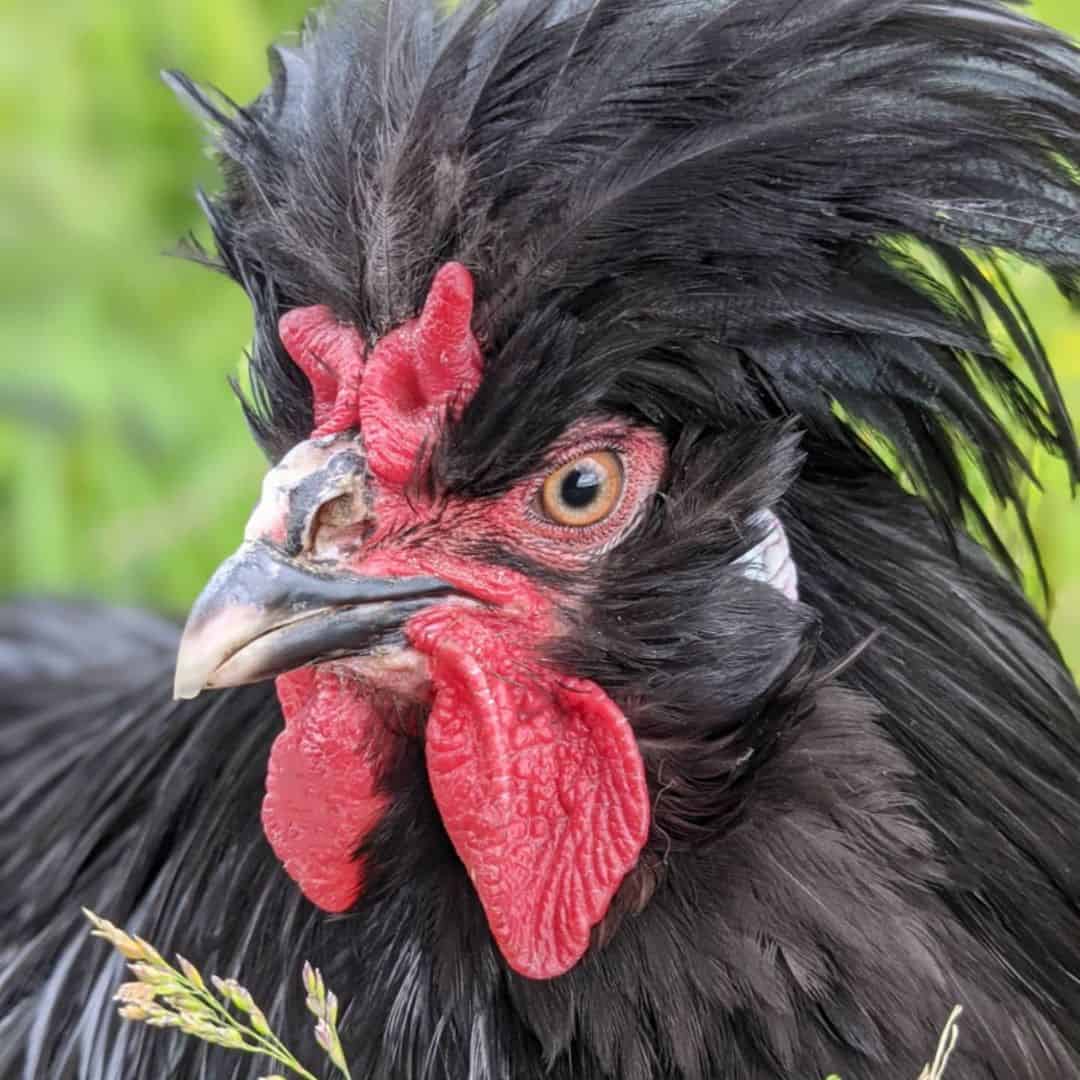
The Crèvecœur breed also as distinctive V-combs called either the devil’s combs or the horn combs that are small- to medium-sized in front of their crest feathers. Their combs look a bit like the La Feche chicken breed as well.
These elegant black chickens have small wattles, and their shanks and toes are dark leaden blue. Their legs are dark grey in color.
The standard Crèvecœur chicks are typically black. However, these chicks possess white patches on their bottoms and some white tips on their wings.
The US-bred Crèvecœur chickens for exhibition rather than meat production, so this breed is smaller than the standard. Because Crèvecœur fowls are large and thickset in physiques, they were initially bred as table birds and dual-purpose species.
The rooster approximately weighs 8 lb while the hen is around 6.5 lb. The Crèvecœur bantam rooster weighs around 30 oz, and its hen is about 26 oz.
Crèvecœur Chickens’ Personality and Temperament
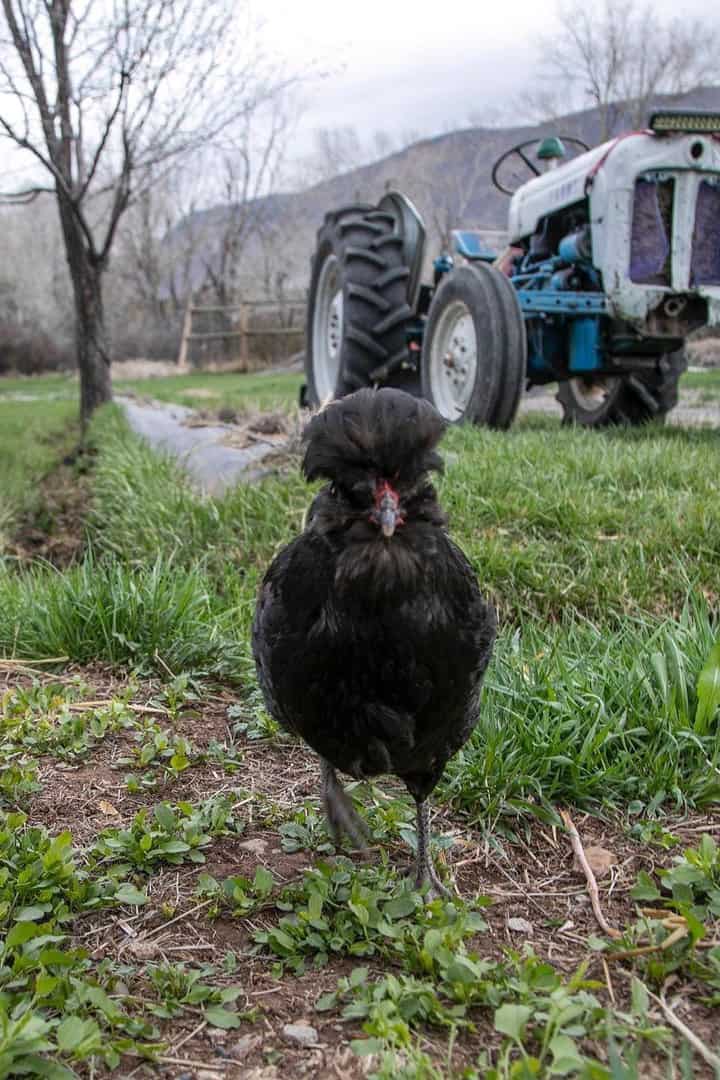
Crèvecœur fowl breed is sweet and docile in nature. You can count on raising a very friendly full-grown chicken when you give time to raise them with lots of attention when they were still chicks. However, even when they have a caring nature, the Crèvecœur hens hardly ever sit on eggs to raise their chicks.
Many Crèvecœur birds seem to be flighty, but the US breeds are very calm. Many breeders claim that among all the chickens they’ve raised, it’s the Crèvecœurs that are the most laidback of all fowls. As much as these black chickens are dynamic, they are famous for being quiet and docile. Most of these elegant chickens are friendly with people.
Crèvecœur birds, in general, are also very active. You can see them sitting still on an odd occasion. These French fowls prefer darting and scratching at whatever interests them. But, these blackbirds are cautious and quiet in movement. Even when active, they do well in confinement and would seem pretty gratified in that environment.
These graceful Frenchies shine in the pet category. Aside from their unique and adorable appearance, these chickens are indeed sweet and friendly.
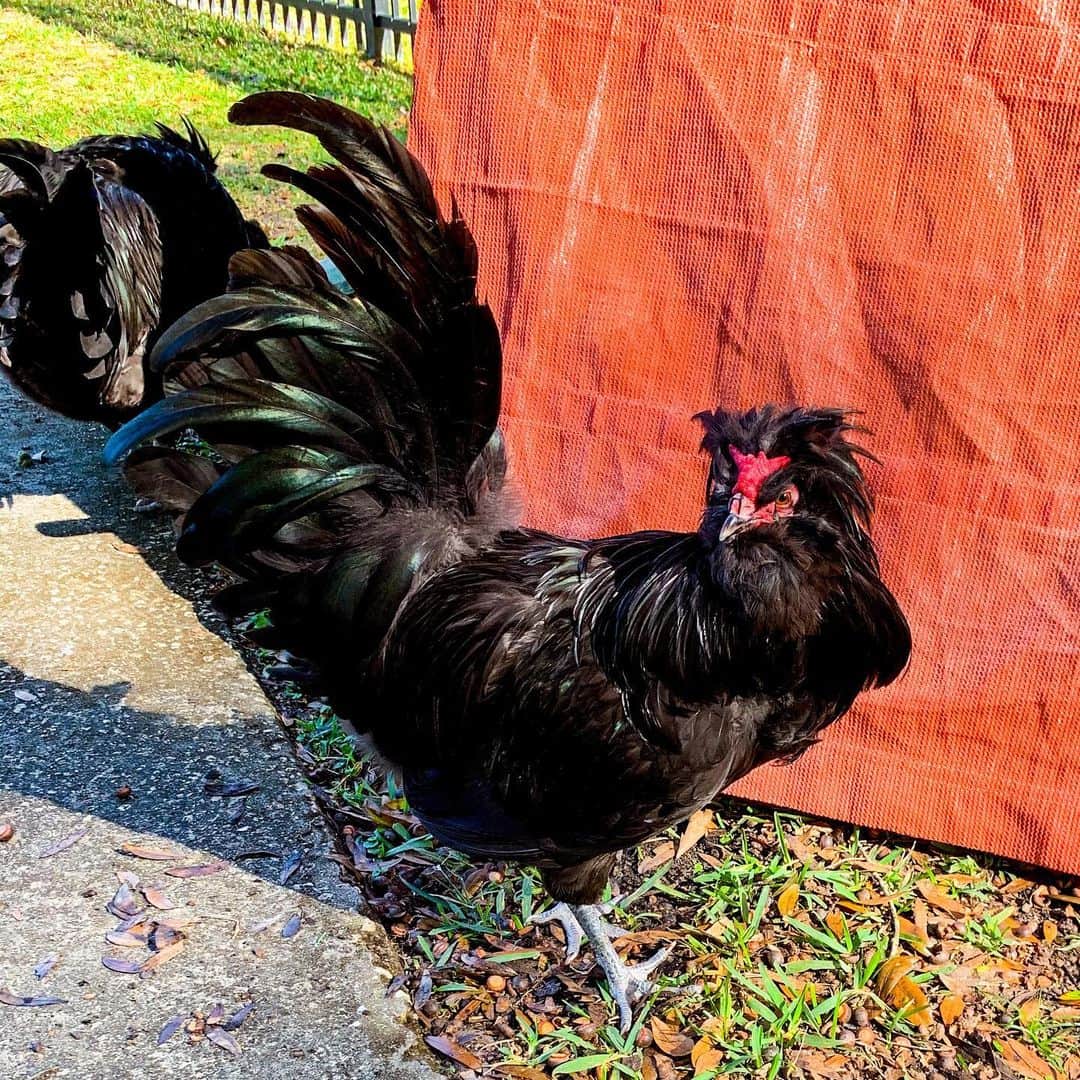
These chickens may be a good start for beginners since they are low-maintenance fowls with dynamic personalities. However, since they are rare, beginners don’t choose them as a starter chicken. But these chicks might be the perfect choice for those who want to raise a breed that is a little out of the ordinary. You’d be surprised how quickly you can hand-tame this pet!
As Crèvecœur chickens’ nature to be calm and cautious, the males can also have random aggression, which is not something to worry about. And although they do remarkably better in confinement, they are not good at range. These rare chickens should maintain a close range to the flock because individuals are effortless targets for predators.
In general, the Crèvecœur chicken temperament is an active strain but does well in confinement that hardly ever goes broody. Breeders describe them as easy to handle, friendly, and calm. Some Crèvecœur chicken breeders declare that certain fowls from this breed display an aggressive side.
Although these chickens are dynamic, they rarely hunt for food. Crèvecœur does well in a backyard setting because they’re not inclined to flightiness and are deliberate and quiet.
Crèvecœur Chicken Egg Laying Details
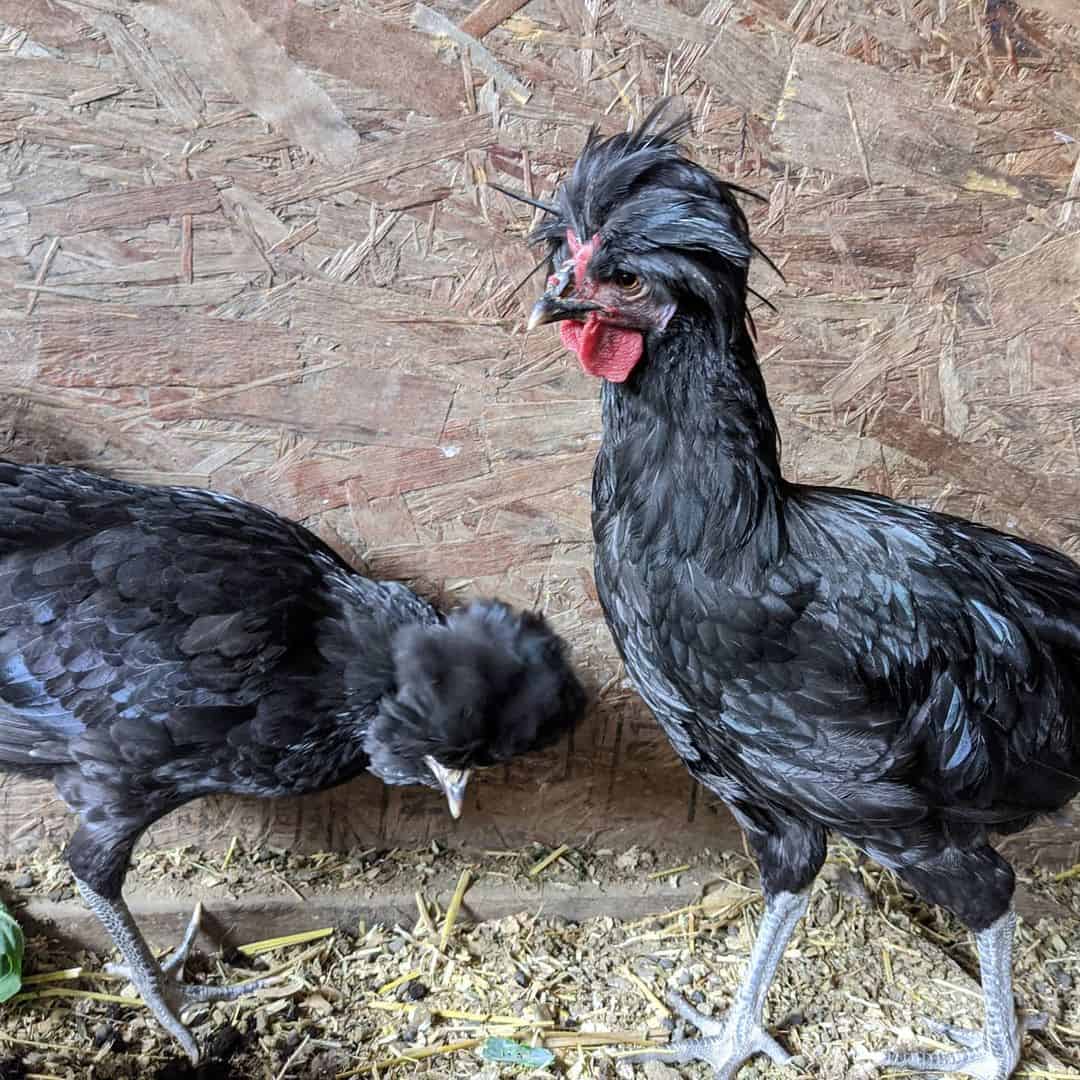
Crèvecœur is not a champion in egg production but is not bad either. They belong to the average group in egg production. You can expect medium to large white eggs from 104- 120 eggs in a year.
Crèvecœur hens do not have regular laying schedules compared to other hens. More so, most Crèvecœur hens begin to lay eggs when they’re 7 – 10 months old because some of these hens take longer to lay than the typical chickens.
What’s surprising in a Crèvecœur egg production is that two features make them better than the average layer chicken breed. First, Crèvecœur hens lay steadily throughout the winter and summer seasons. In fact, these hens lay eggs efficiently well during wintertime. That’s better than other breeds that do not lay eggs during these seasons of the year.
The second surprising fact is that older Crèvecœur hens still lay eggs. One backyard chicken raiser declared that his Crèvecœur hen continued to lay eggs even at its seventh and eight years of life.
Crèvecœur mother chickens age charmingly from egg layers to backyard pets. So, even when these fowls are lingering to begin egg-laying, they can make it up for you by laying eggs during the winter and the duration of laying.
Because the breeding of Crèvecœur chickens’ primary purpose was for meat production, these French black chickens are not bad performers in the egg production either. Their lack of skill in laying eggs early is compensated by laying eggs until old age and even during the summer and winter seasons.
Crèvecœur Chickens Health Issues and Care
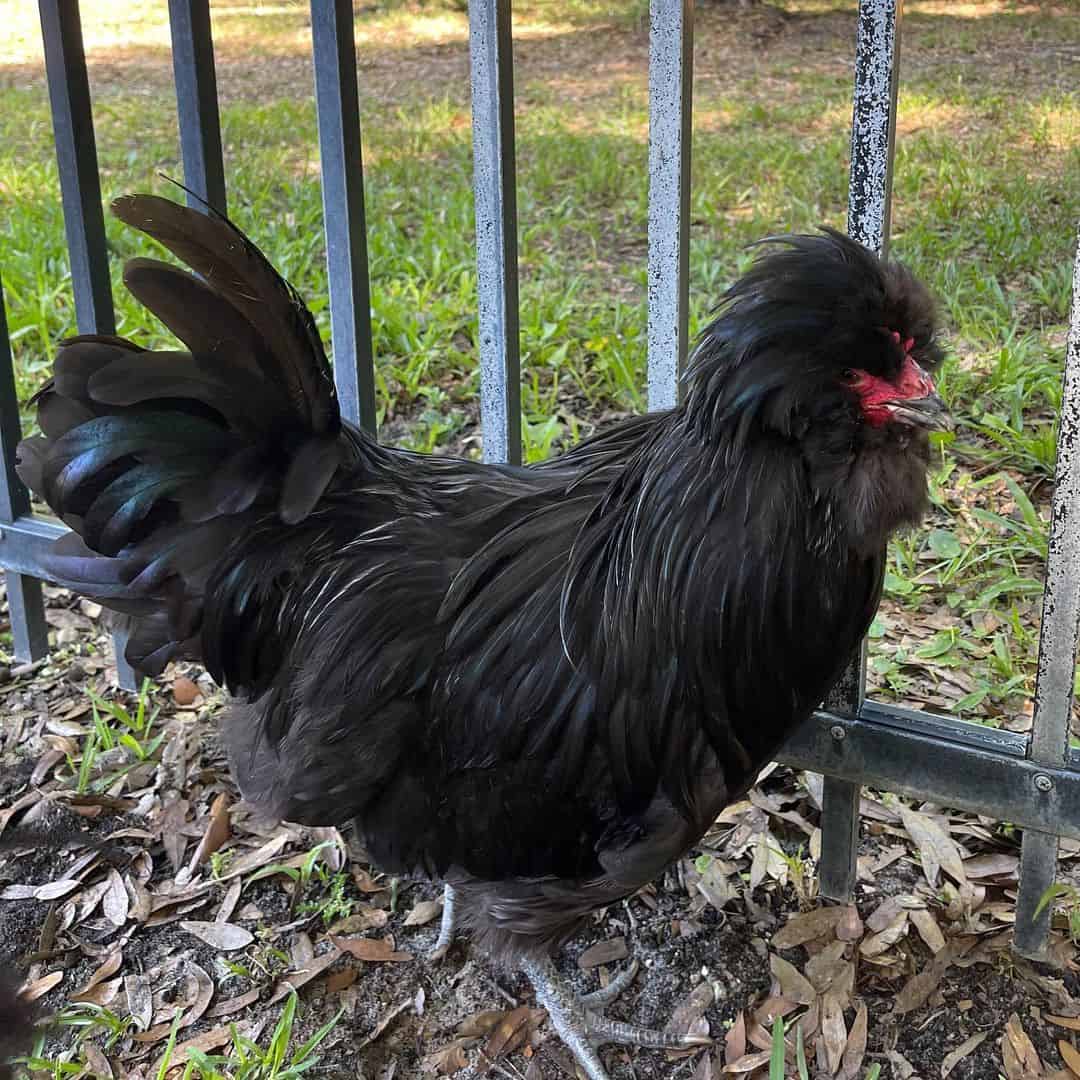
There are three things to consider in taking care of Crèvecœur fowls.
Nutrition
The best is yet to come for your Crèvecœur chicks, so it’s best to feed them for their first 8-12 weeks on a chicken starter. But, make sure it’s an excellent quality of chicken starter feeds. Then, when your chickens are getting ready for egg-laying, it’s now the best time to shift on to also an excellent egg-laying feed.
It’s also crucial to add some supplements in your laying hens, such as extra calcium, especially if they’re not getting enough of it from their feed. It’s simple to add calcium supplements to your chicken feeds.
Eggshells are a great source of calcium supplements when you have removed the membranes before crushing them. Also, critical to remember to crushed the eggshells so well to avoid establishing an egg-eating habit in the future. Another sustainable choice is crushed oyster shells in delivering extra calcium supplements to your Crèvecœur chickens.
Housing
Unlike other active birds, Crèvecœur breeds go well in confinement even when they’re very dynamic. So, if you don’t have a lot of space, they’re an admirable breed to raise.
No matter how small your space is, make sure you can provide at least 3-4 square feet of space per Crèvecœur chicken. This space is to ensure that each chicken has a suitable area to sleep and escape from elements.
As Crèvecœur are active birds, make sure you still have space for them to stretch their legs and wings and to peck around. At least a 10-square feet per chicken is an excellent spot to begin running or planning on how many Crèvecœur birds you plan to breed soon.

Health Concerns
There are no health issues breeders experience when raising Crèvecœur fowls as these are hardy birds. Though these French black chickens are for vitality, they can still be susceptible to numerous diseases and illnesses. However, there has been no record for hereditary concerns from this breed.
A Crèvecœur chicken breeder should guard their fowls with external and internal parasites. The application for the internal parasite treatment is easy as you can mix it in the chickens’ water to minister to the whole flock in the coop at once.
It might be challenging to treat external parasites since you have to treat each Crèvecœur chicken individually. One Crèvecœur chicken external parasite treatment for prevention in a mite or lice outbreak is a good dust bath.
It’s also a keynote to observe that it may be more susceptible to an eye infection if this black chicken has an enormous crest. Trim the feathers, especially if it’s having difficulty seeing through the feathers on their faces. More so, when the feathers on their faces are dirty, trimming or taping are the options to protect their eyes from infection.
Furthermore, nipple waterers are better than bowl-type waterers for your Crèvecœur breed. This type of waterer prevents your chickens’ feathers and crest from getting wet, which is very significant during cold temperatures.
5 Tips For Raising Crèvecœur Chickens
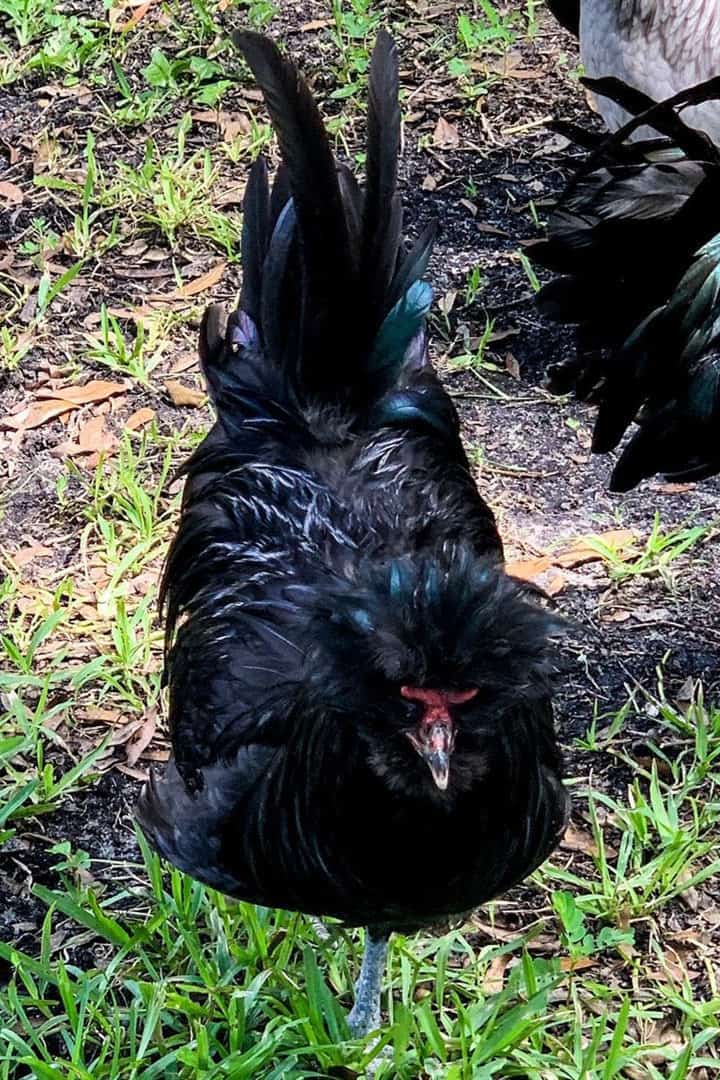
Picking Crèvecœur to raise is a fantastic idea due to its being a gravely endangered breed. These original French chickens don’t possess complex feather patterns, which means they’re stress-free to keep in your coop. They are low-maintenance fowls, except they need extra care during the winter season. More so, predators avoid them because of their size.
Here are some general tips on how to breed Crèvecœur chickens to the standard of perfection!
Grooming
These graceful black chickens love dust baths to bits. So, adding herbal substances blended into the loose sand will make your chickens happier. These dust baths are vital for the chickens to free their plumes of excess oils, pests, and external parasites.
For beginners, it’s not challenging to regularly check each Crèvecœur chicken for mites, lice, or other several parasites because they are pretty easy to handle. Regular examination of pests in their feathers should be done at least once a week to keep your Crèvecœur fowls healthy. Furthermore, regular de-worming is a must when your chickens are around other animals, or they’re mingling with kids.
Diet and Nutrition
A balanced diet for your Crèvecœur chicken when they’re 8 weeks and older are chicken pellets, grain mix or chicken mash, and grains. This diet should be their first meal of the day before they roam around and peck on the ground. This first meal in the morning will provide them the nutrients these black chickens need.
Chick Starter is the best food for chicks under eight weeks old. And Crèvecœur hens laying eggs need extra calcium and protein in their diets as well. These supplements will provide a better quality of their eggs and maintain good health for the hens.
Crèvecœur chickens also love leftover vegetables and fruits. Did you know that these lovely chickens would love your table scraps of fruits and veggies when you served them in ice cubes on hot days? More so, these French chickens will appreciate more of your extra attention in hand-feeding them their snacks.
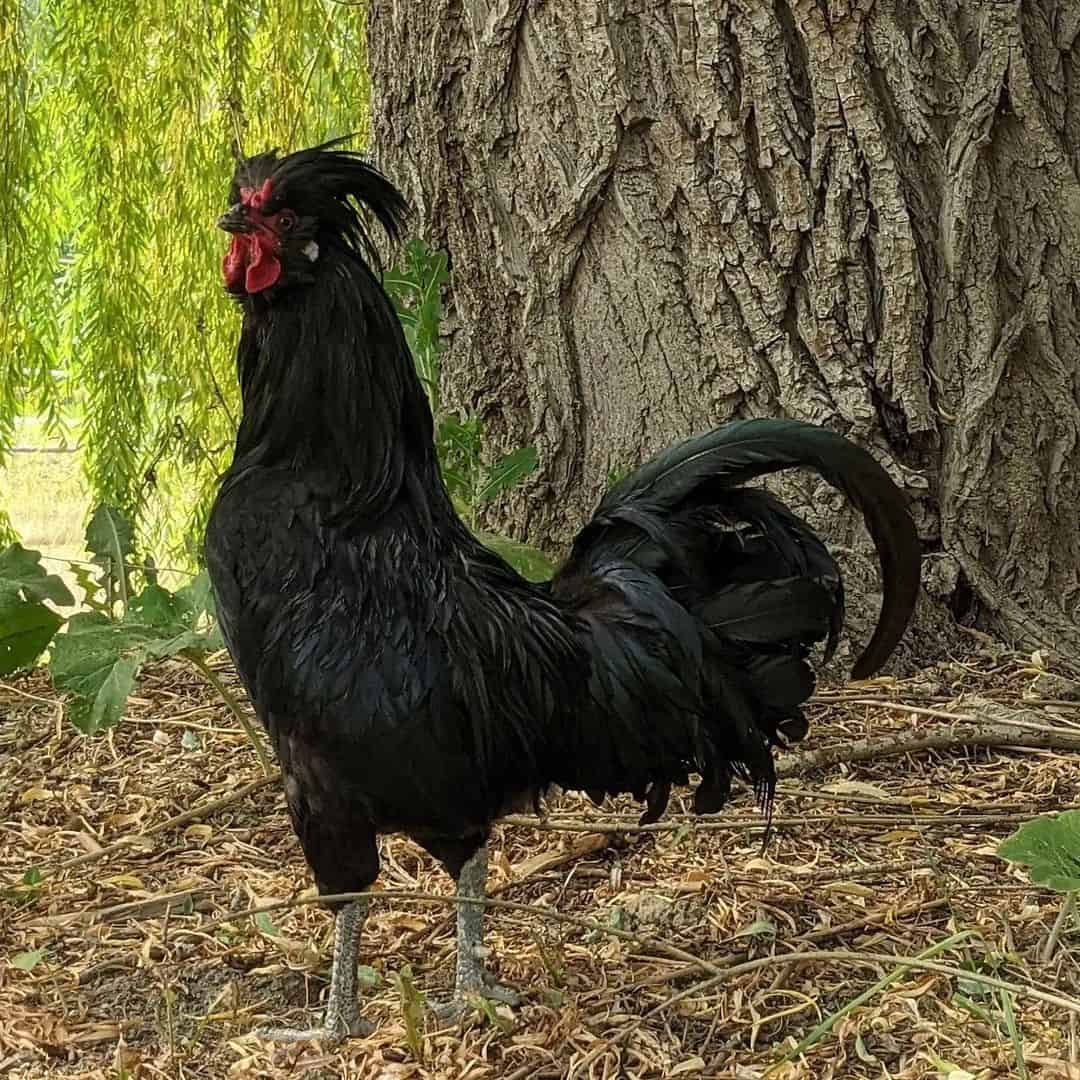
Crèvecœur Social Life
Crèvecœur chickens are gentle in nature, so it’s not hard for them to socialize. Still, unfortunately, because of their personality, they tend to be at the bottom of the pecking order. So, make sure they mix with other gentle and kind birds that will not terrorize or bully your Crèvecœur breed.
It’s crucial to check on the chicken breeds that you will add or mix in your coop with your existing strains before buying them. A new set of chicken breeds may bring stress to your current flock. Mixing Crèvecœur chickens with other fowl strains with a gentle personality that matches theirs will keep the peace and peacefulness of your coop.
It’s imperative to quarantine a new set or individual chicken in your coop for 7-31 days. This quarantine guarantees that there will be no internal and external parasites or existing diseases the newcomer has that might infect your existing flock.
Climate for Crèvecœur
These birds do well on hot days, and you’ll find it surprising that these hardy birds are remarkable in dry climates. These hardy fowls can do well during wintertime as well, if not for their crests and beards. Their crests and beards can get wet (especially drinking water from a bowl type of waterer) and freeze in wintertime. Your Crèvecœur would keep flipping its head when icicles develop on their beards.
If you live in a cold climate, think twice before deciding to raise Crèvecœur chickens. Not doing anything to avoid your chickens’ face feathers freeze into icicles is a cruel way to breed fowls.
Your chickens would be prone to frostbite as well as it’s highly uncomfortable for them. But if you decide to raise Crèvecœur chickens and you live in a cold climate, make sure you have a Sweeter Heater above their roosting bars so they can thaw out.

Crèvecœur Environment
These chickens from France prefer free-range, but surprisingly they also do well in confinement. Crèvecœur breeders claimed that their confined fowls seem to be contented with confinement. Other Crèvecœur breeders call these chickens as escape artists.
Take note that these birds are excellent fliers, so it’s a better idea to cover your run if you prefer them confined.
A covered run is the best decision for confined Crèvecœur chickens, for they’re famous for ascending high fences. A covered run will also save their muffs, beards, and crests from freezing during a severe winter climate.
If your area is vast enough to free-range your Crèvecœur, that will make them grow happy. In general, these black chickens are adventurous and dynamic, and they adore exploring the area.
Buying Crèvecœur Chicken
Crèvecœur chicken is on the list of critical conservation status. You must check if you need an additional license to keep one in your homestead. You can check your local conservation department for the Crèvecœur chicken’s conservations status and orders.
You must check your chicken’s bloodlines for fowl raisers when you buy them from a reputed farm or breeder. Make sure these chickens have records and documents with your local animal breeding organizations for you to sell such fowls. Poultry shows or competitions also require you to present your legal documents for your Crèvecœur chicks.
Conclusion
Although Crèvecœur translates its name as “broken heart,” these black chickens from France will never break its breeder’s heart. If you plan on raising chickens for table bird, show bird lineup, or chicken run, Crèvecœur chickens will make you happy. Any breeder enjoys the presence of this unusual chicken in their coop or homestead.
Besides, even when these black chickens are dynamic birds, Crèvecœur do well in confinement and rarely acts broody in the coop. So, their calm and friendly nature are also suitable for beginners.
Since Crèvecœur chicken is exceptionally famous for being friendly, you hardly ever witness this bird being aggressive. But being social isn’t enough for a Crèvecœur chicken to be a family pet. There are challenges in raising this breed like any chicken breeds do.
More so, beginners might be having problems with Crèvecœur chickens because they require a lot of time and attention every day. That’s why if you don’t have any background intending chicken, better think twice before deciding to raise your very own Crèvecœur chicken.
This black chicken will be a delightful addition to any coop. What’s more important are the Crèvecœur’s personality and striking appearance, which never fails to put a smile on its breeder.
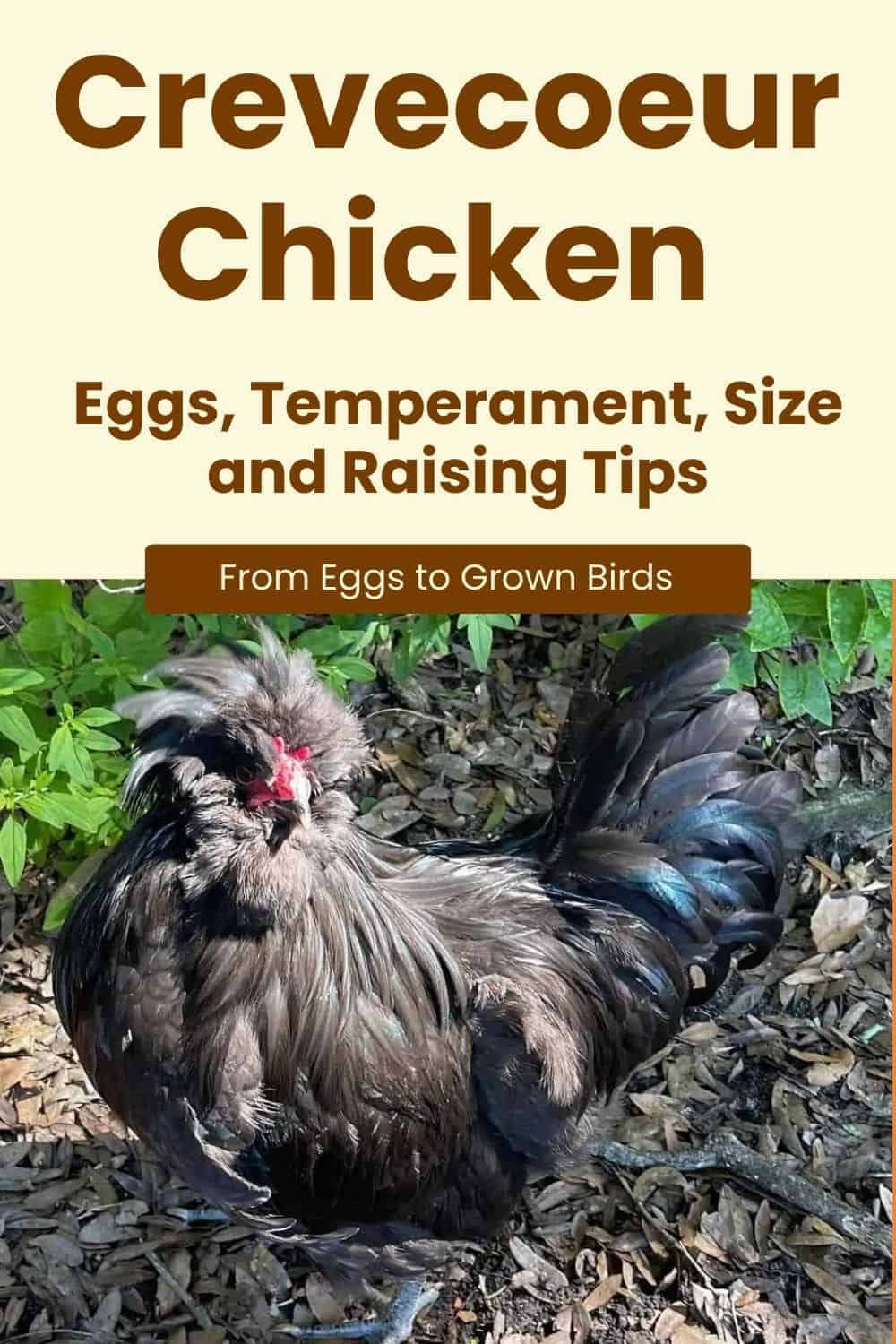

Joseph Hudson has been raising chickens for over 15 years. In 2018, he completed the Agriculture & Natural Resources program at Mt. San Antonio College. He currently raises over 1400 chickens on his 7.5-hectare farm. He keeps sharing his experience on raising healthy and happy chickens on Chicken Scratch The Foundry.
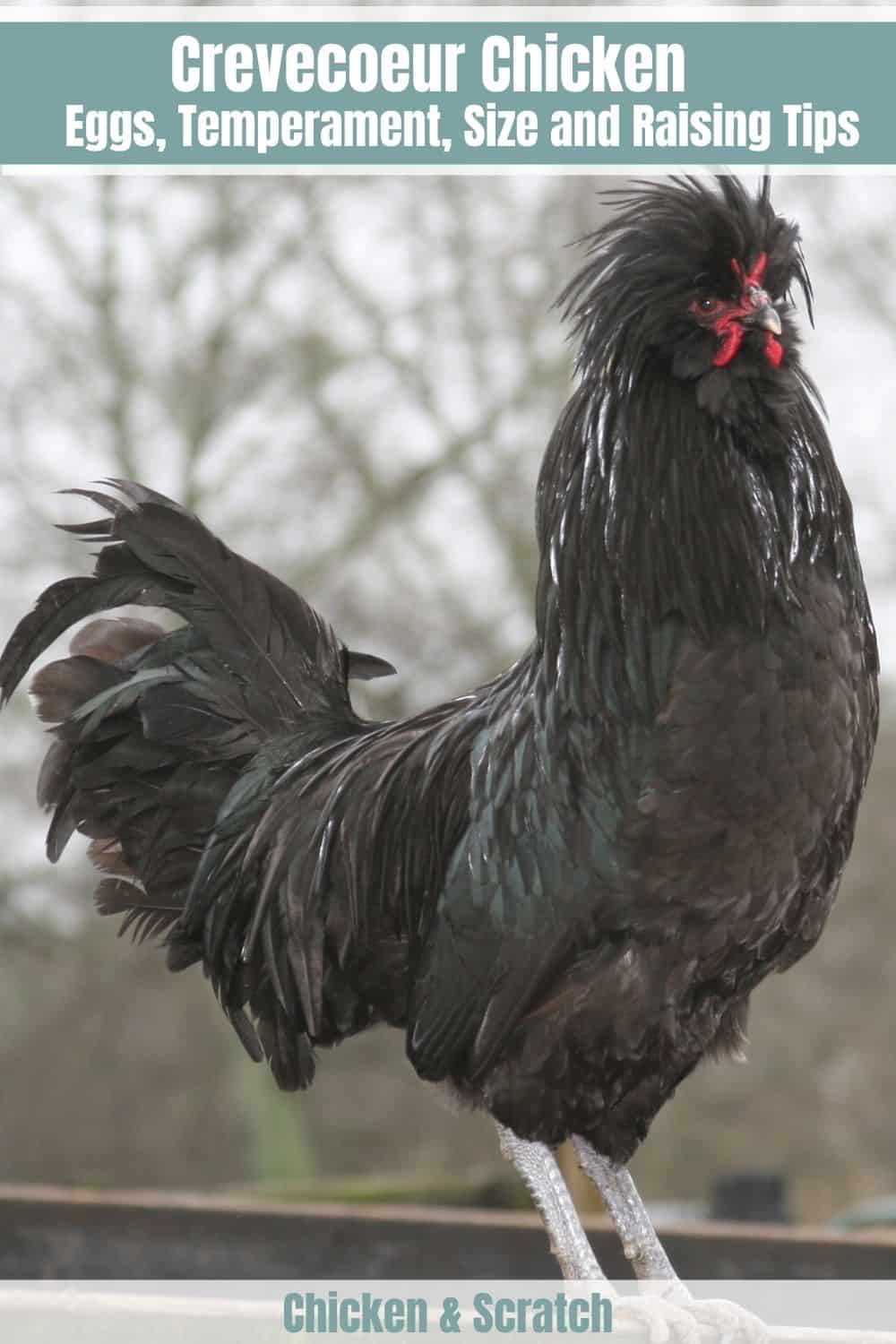
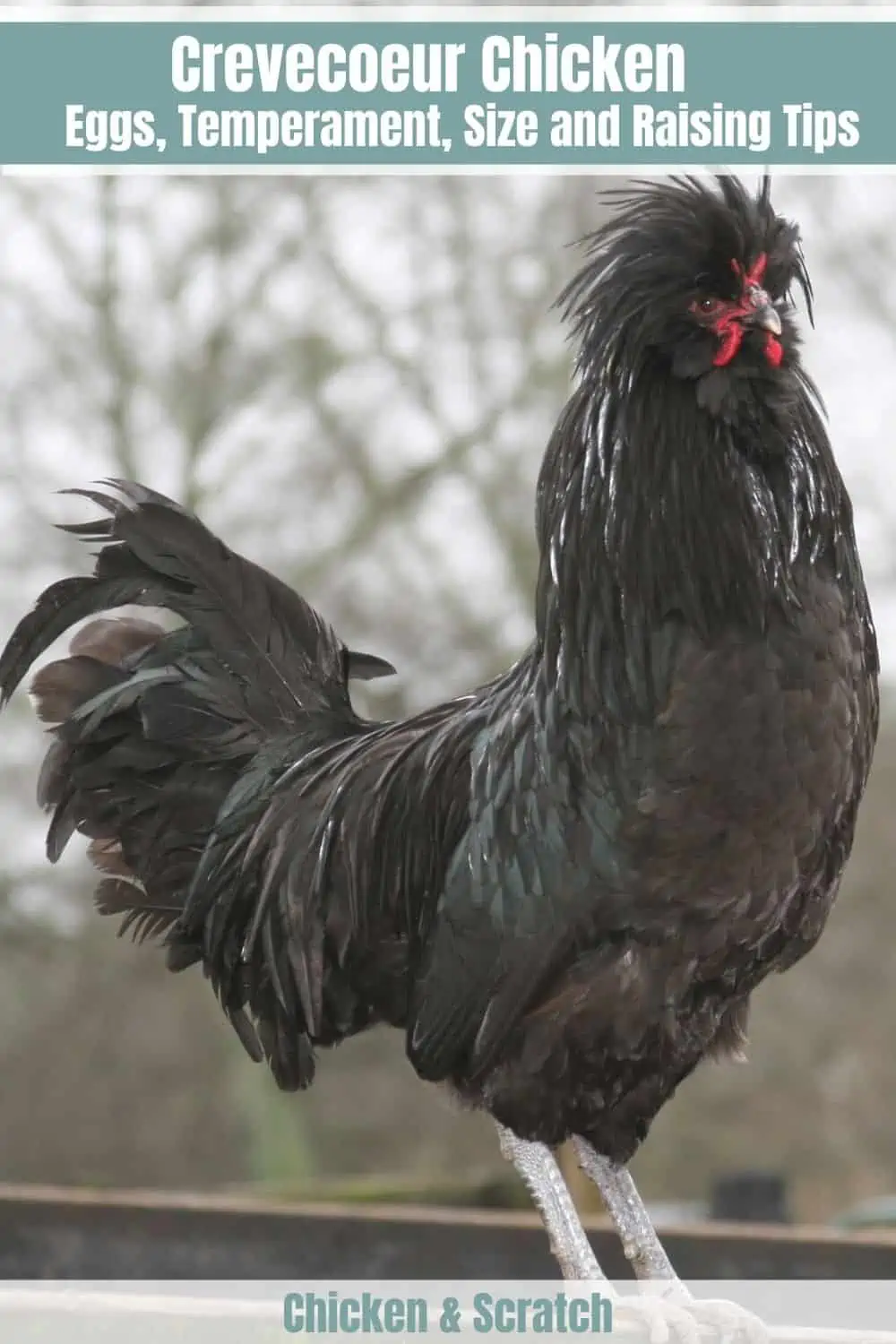







I would love to be entertained on the dynamics of how the SOP for the crevecouer has included the red in the ear lobes? No you didnt mention this in the article. The SOP is the only standard we have known since the 1800s for the Crevecouer. The American Line of the Crevecouer stands tall and leaner like the ones that you show in the pictures. The French model is a Squatier more robust bird having very thick legs and weighing in at nearly 9lbs. We currently have Full French models and American Models. We also Have Blue which are absolutely Huge. Thank you for the article. Please contact me soon
I received a breeding trio in some birds I purchased from a breeder. I just had 9 babies hatch today. I live in INDIANA.
Congratulations on your newly hatched Crevecoeur chicks! Since you live in Indiana, be aware that these chickens are well-adapted to a range of climates, but they might require some extra care during the colder winter months. Make sure to provide them with a warm and draft-free shelter.
I purchased my chick’s in April 2023. They are now 5 Mos old. I was told that they were polish but I am not in agreement. My two birds are crevecoeur . My rooster is solid black with one single white feather on his head. He is aggressive at the moment . I have a variety of hens, 8 total with another rooster that is a legwork and he has been head of flock . My crevecoeur male is trying to dominate me as well as other flock member’s. He is very large and beautiful and I’m not sure how to handle him. I also need to know how to check if he Isa pure crevecoeur. Can you give me some informn.
Hi Cheryl,
Hello!
Identifying if your rooster is a pure Crevecoeur can indeed be challenging. To confirm, check for characteristics like a V-shaped comb, a horned beak, and a rounded body which are typical for Crevecoeurs. Consult with a poultry expert or a specialized breeder for a precise assessment.
Regarding the aggressive behavior, it is fairly common in young roosters establishing dominance. You can maintain a safe distance using a stick or a broom while interacting with him and avoid direct eye contact to mitigate aggression. Ensuring ample space and possibly separating him briefly from the flock might help in reducing his aggressive tendencies.
Remember, it’s crucial to continuously monitor the dynamics between him and the other rooster to prevent any serious clashes.
I hope this helps. Good luck!
Best,
Your friendly poultry adviser